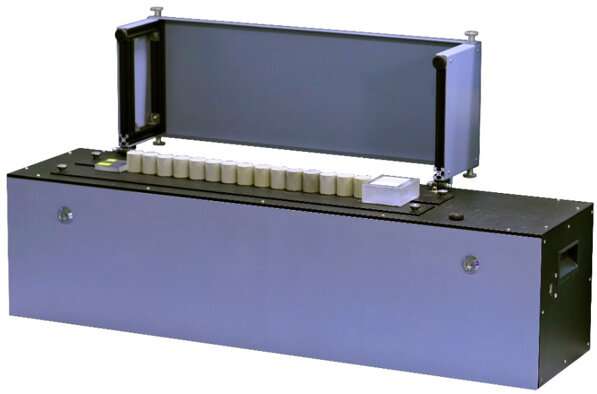Model of rock thermal conductivity used by oil and gas and geothermal companies proves unreliable

Skoltech researchers have leveraged their unique experimental data and expertise in rock modeling to test a theoretical model of rock thermal conductivity commonly used for the search, exploration, and development of oil, gas, and geothermal fields and in radioactive waste disposal. The study, describing a way to significantly improve the model, was published in the journal Geothermics.
Rocks are difficult to study and model due to their diverse compositions and fabric (structural features), which reflect their formation conditions over millions of years. Their properties are much harder to study compared with those of industrial materials, since rocks are heterogeneous and uniquely structured by nature. The situation is further complicated by the shortage of rock samples for lab experiments, so it is unsurprising that scientists have to make do with theoretical modeling using approximations that largely oversimplify both the structure and the properties of rocks. This results in poor quality of input data and low reliability of the modeling tools used in the oil and gas and geothermal power industries, radioactive waste disposal, and by other professionals who rely on insights about the underground thermal regime.
The current approaches to rock thermal conductivity prediction are based on simplified theoretical models that do not do justice to the variety of factors determining this rock property. As a result, thermal conductivity assessments can differ by hundreds of percent between various theoretical models. In their paper published in Geothermics, Skoltech researchers and their colleagues argue that the most popular thermal conductivity model is rather unreliable, especially as regards porous rocks.
“We tested the performance of the most popular theoretical model of rock thermal conductivity and found major errors in its outputs, which led us to describe a way to improve thermal conductivity modeling,” paper co-author and Skoltech Professor Yuri Popov says. “Our study relied on Skoltech’s extensive theoretical expertise and a large-scale experiment, which involved nondestructive high-precision measurements of the thermophysical properties of rocks. We used our unique in-house equipment on a vast array of samples, studying as many as 1,750 rocks from different regions—a most valuable collection of natural material that we received from Skoltech’s industrial partners owing to our close collaboration.”
The errors in the prior model of porous rock thermal conductivity stemmed from the extreme simplification of rock as a medium, since the model ignored the structural features of the rock and only accounted for the thermal conductivity of its components and their volume fractions. In part, this happened because obtaining reliable experimental data on the thermal conductivity of sedimentary rocks for testing the model remained an intractable problem until recently. Earlier data on the thermal conductivity of rocks obtained by conventional techniques and cited in the existing reference books and databases call for a thorough revision in most cases. The lack of rigorous quality control of experimental data on thermal conductivity has led to a false understanding of the ranges of this characteristic’s spatiotemporal variations, resulting in major problems in the application of modern thermohydrodynamic simulation software.
“The reliability of thermal conductivity data is often neglected in practice: Some believe that an error in these values has little effect on the calculation results, while others argue that they know everything about the thermal conductivity of rocks and can easily calculate it. Still others resort to the default values in their simulators. Previously, we showed that a lack of up-to-date thermophysical properties could lead to major errors of several dozen percent, for example, in heavy oil production forecasts—a nasty surprise for many experts. If, however, the improvements we propose are implemented in thermal conductivity modeling in simulators, the reliability of the production forecasts will substantially increase,” Skoltech Leading Research Scientist Evgeny Chekhonin notes.
“While our suggestions for improving the quality of thermal conductivity modeling make that process more complicated, this nevertheless demonstrably leads to significantly more reliable estimates of the target parameter. When it comes to porous and fractured reservoir rocks, such predictions are important not just for hydrocarbon extraction, but also for geothermal energy. Beyond that, reliable thermal conductivity estimates are crucial for underground radioactive waste storage, because this minimizes the risk of rock overheating, which might lead to further fracturing and hazardous fluid leakage toward the land surface,” professor Popov adds.
Z. Pichugin et al, Weighted geometric mean model for determining thermal conductivity of reservoir rocks: Current problems with applicability and the model modification, Geothermics (2022). DOI: 10.1016/j.geothermics.2022.102456
Citation:
Model of rock thermal conductivity used by oil and gas and geothermal companies proves unreliable (2022, July 28)
retrieved 28 July 2022
from https://techxplore.com/news/2022-07-thermal-oil-gas-geothermal-companies.html
This document is subject to copyright. Apart from any fair dealing for the purpose of private study or research, no
part may be reproduced without the written permission. The content is provided for information purposes only.
For all the latest Technology News Click Here
For the latest news and updates, follow us on Google News.

